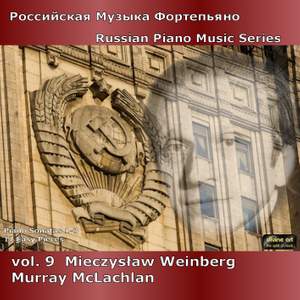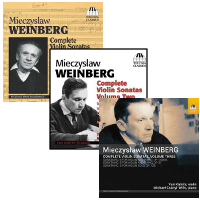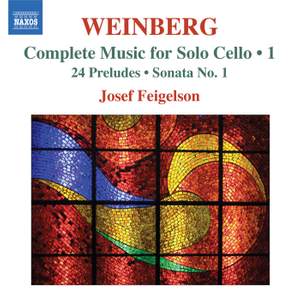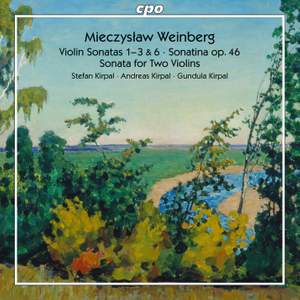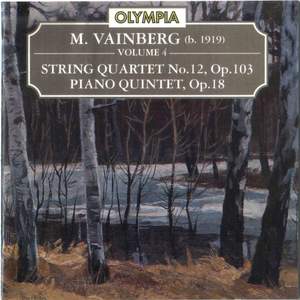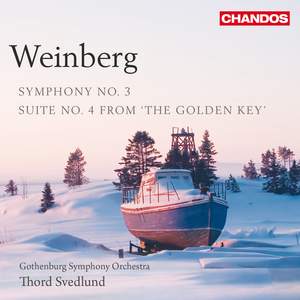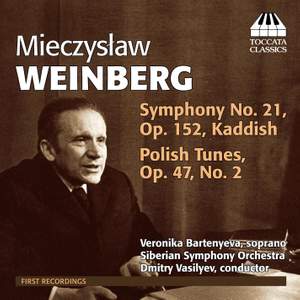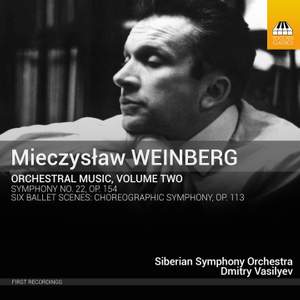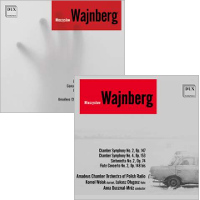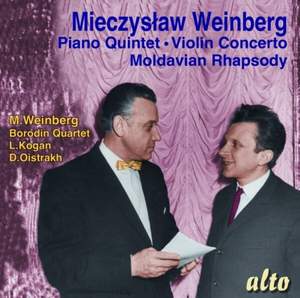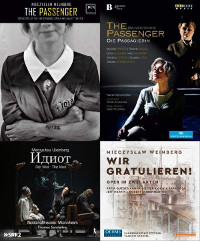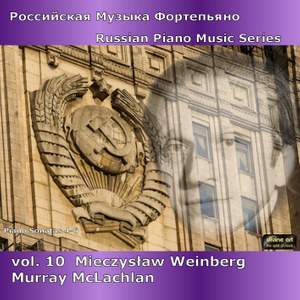
Divine Art DDA25107, Russian Piano Music Series, Vol. 10
UK, 2012
Review: Murray McLachlan originally recorded all of Weinberg's piano sonatas for Olympia in the mid-1990's, and these two recordings – which were unavailable for a long time – were re-released on Divine Art in the early 2010s. McLachlan's interpretations are superlative: intelligent, rhythmically sensitive, and completely sympathetic to Weinberg's pianistic idiom. In comparison, under Allison Brewster-Franzetti's hands Weinberg's sonatas sound livid. Elisaveta Blumina brings a strong sense of poetry in her interpretations on CPO; however, Weinberg's lyricism is not of the Romantic type (see the Further Reading page), and Blumina's shaped and sometimes sustained phrases have a tendency to blur the poise and neo-classical tendencies of the music, even though the playing is never less than heartfelt. As one reviewer has already noted, later attempts to interpret a musical creation do not always supplant earlier ones, and despite the different approaches of Elisaveta Blumina and Allison Brewster-Franzetti, it is Murray McLachlan's renditions from the 90's that are the must-have ones – with Elisaveta Blumina's versions of the 1st, 2nd and 4th sonatas as good alternatives for those interested in seeing another perspective on the music.
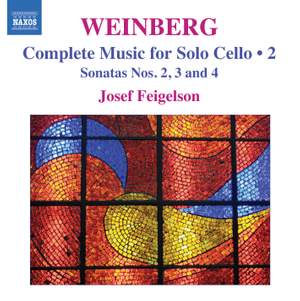
Naxos 8572281
Germany, 2011
Review: Josef Feigelson's renditions on Naxos of Weinberg's three late towering works for solo cello is another re-release of an older Olympia recording from the mid 1990s. To date, Feigelson's exceptional insight into these pieces and his ability to convey their profound emotions remains unparalleled.
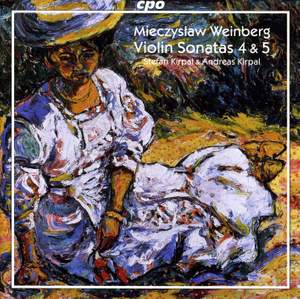
CPO cpo-777-4562
Germany, 2009
Review:
Weinberg's 4th and 5th violin sonatas are highly approachable, lyrical, yet deeply serious works that perfectly exemplify the early years of his mature style; it is no surprise, therefore, that they have been recorded numerous times. Different recordings have different merits and each one attempts to shed a different light on the works. Among these many performances, however, the one that truly stands out is by Stefan and Andreas Kirpal on CPO. Both musicians seem to have unparalleled insight into the music, and play with such exceptional sensitivity, understanding, nuance and depth, that the only way of describing the result is “eminently natural”, indeed, in many ways ideal
. No other interpretation of these two violin sonatas reaches the same interpretative heights – the Diapson d'Or which this CD received is well-deserved.

Dux DUX1545
Poland, 2019
Review: Wojciech Fudala and Michal Rot present emotionally charged accounts of Weinberg's two accompanied cello sonatas on the Polish label Dux. Both sonatas are eminently accessible, with the second being perhaps one of Weinberg's most poetically-lyrical works. The performance compares very well to that of Alla Vasilieva and Weinberg himself on the piano, which is the long out-of-print (and in some sense unsurpassable) benchmark recording for these two pieces; indeed Fudala's delicate, soulful tone, recorded in excellent sound, is more than a match for Vasilieva. In terms of the remaining pieces on the CD, Weinberg's first solo cello sonata receives a passionate reading that is comparable to Josef Feigelson's interpretation on Naxos, though with slightly different emphases throughout. The lullaby for piano which rounds off the program (Weinberg's very first opus number) is a charming addition from the composer's pre-war Polish, neo-impressionistic period, performed very sensitively by Rot. An earlier CD recording on BIS with Alexander Chaushian on cello and Yevgeny Sudbin on piano is decent with respect to the accompanied sonatas, though the pair have a tendency to occasionally drag out the music. Dmitry Yablonsky and Hsin-Ni Liu's rendition on Naxos is likewise adequate, though Liu's accompaniment is not as tight as it can be. Neither recording reaches the poetry and deep emotional involvement of Fudala and Rot.

CPO 777630-2
Germany, 2012
Review: This imaginative program combines the early clarinet sonata and flute miniatures, containing some of Weinberg's most delightful music, with the late chamber works for wind instruments, which are among the composer's most meditative pieces. It is performed superlatively in every way by Elisaveta Blumina and colleagues. In the bassoon solo sonata, Mathias Baier not only surmounts all the technical complexities with ease, but successfully projects the cool, mysterious beauty of the work that seems to stand up to infinitely many listenings, each one revealing new details; but then, so does the trio for flute, viola and harp, and the clarinet sonata, and... The recording is a real treasure.

Sony 19075937152
Germany, 2019
Review: Weinberg's piano quintet from 1944 – a work densely impregnated with ideas – is an early masterpiece of the genre, alongside Shostakovich's single quintet from 1940 and Martinů's two piano quintets from the 1930s. In contrast to these other works, which are, in a sense, stylistically homogeneous, Weinberg's quintet amalgamates a wide variety of stylistic traits to narrate its sprawling, and ultimately unfinished, story. The works's simultaneous density and variety is no doubt one reason why it has been so popular with musicians and so often recorded, both alongside other works from Weinberg and in combination with Shostakovich's quintet. Of these many, excellent performances, one of the most lucid and compelling is by Olga Scheps and the Kuss Quartet on Sony. While the recording tantalizingly leaves room for more pieces (some of Weinberg's piano music or a sonata would have been a welcome addition to a 45-minute CD), the refined playing of the musicians makes up for the short timing. Of special note is the sublime mood which the Kuss Quartet conjures in the central slow movement, and the clear, balanced, and highly intelligent playing by Scheps throughout. Overall, the musicians manage to recreate the clarity and coherence of the benchmark Soviet-era recording with the Borodin Quartet and Weinberg at the piano, while placing their own unique interpretative touches.
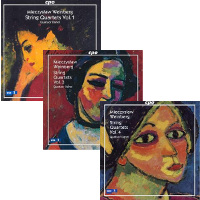
CPO 7773132, 7773932, 7773942, 777913-2 [box-set]
Germany, 2007 – 2009, 2014
Review:
Like the symphonies, Weinberg's string quartets span his whole career and, therefore, present both performers and listeners with music of tremendous variety (within Weinberg's stylistic idiom, of course). Perhaps for this reason, it is not entirely reasonable to expect that a single ensemble tackling the whole cycle of 17 quartets – a most commendable undertaking, in all respects – will be equally successful across every single piece.
The Belgian Danel Quartet was the first to tackle the whole series, making many world premiere recordings along the way. While their interpretations are never less than devoted (Marc Danel has candidly spoken about how the members of the quartet had to copy parts by hand from the originals, and wrestled for concert performances of the music in days when Weinberg's name was hardly known), the most successful interpretations are of quartets Nos. 4, 5 and 6 (from Weinberg's early mature period); Nos. 8 and 9, from Weinberg's middle period; and Nos. 14, 15 and 16, from Weinberg's late period. The last three of these quartets use a somewhat more modernistic palette and are less approachable on first listening, but soon reveal their beauty. In these three late quartets in particular (14, 15, 16), the performances by the Danel Quartet are simply superb. Given that most of the aforementioned quartets were world premiere recordings, one wonders whether the absence of any prior examples forced the ensemble to explore the music's depths and search for purer interpretations, as opposed to attempting to differentiate themselves from any predecessors. (As an aside, at present CPO only offers the complete cycle as a box-set, and this too can be recommended, but it is Vols. 1, 3 and 4 within the set that receive full recommendation).
In terms of alternatives, there are currently two main contenders: the Silesian Quartet's complete cycle on Accord, and the Arcadia Quartet's ongoing series on Chandos. With respect to the former, the Polish ensemble provides spirited, lucid and tightly-knit readings, captured in superlative sound (indeed, Accord's sound engineering is noteworthy among all releases for its naturality and ambience); it is all the more regretful, therefore, that the ensemble often seeks to over-project what they see as moments of anguish and despair, thereby eliding the music's transcendence, solace and, at least in some of these moments, meaning. To take just one example, in the 16th quartet (dedicated to Weinberg's sister, Esther) the Silesians bring out the complex, driving rhythms of the first movement with great clarity, but completely miss to project the Jewish folk-element in the music, its striving and soulfulness, which the Danel's do to great effect. In the slow movement, the Silesian Quartet conjures up an atmosphere of sadness and desolation, not one of devotional introspection, as the Danel Quartet does. Despite this, the Silesians' renditions of the 7th and 10th quartets especially (Vols. 1 and 2 of the series) – though still subject to some mild criticism – are overall very good, and more successful than the Danel Quartet's counterparts.
The approach taken by the Arcadia Quartet is almost the exact opposite of that taken by the Silesian Quartet: their interpretations are warm and overtly lyrical, strongly emphasizing the folk elements where possible, while searching for hidden musical depths. Sometimes this softer approach works; but not always – e.g. in the third movement of the 7th quartet, where the diffusion of lines results in a lack of coherence. Moreover, the overt, neo-romantic warmth which the Arcadia Quartet brings often supersedes something of the finely etched sublimity of the music (e.g. in the slow movement of the 11th quartet). Nevertheless, the care with which the ensemble palpably seeks to interpret Weinberg deserves admiration.

ECM 4810669
Germany, 2014
Review: This recording marked Gidon Kremer's first exploration of Weinberg's music on ECM, and it is by all accounts excellent. Both chamber and orchestral works are included in a varied program spanning most of Weinberg's career. All pieces are performed extremely well, with the interpretation of Symphony No. 10 being a special highlight. With respect to this work in particular, Gidon Kremer and the Kremerata Baltica compare very favourably to the benchmark Soviet-era recording with Rudolf Barshai conducting the Moscow Chamber Orchestra, controlling the challenging interplay between instrumental interludes and orchestral narratives, as well as the frenzied polyphony in the final movement. Of alternative recordings, the rendition of the same symphony by Anna Duczmal-Mróz and the Amadeus Chamber Orchestra of Polish Radio on CPO is not as recommendable, not least due to the choice of drawn-out tempi. This is quite regrettable, since Anna Duczmal-Mróz's interpretations of Weinberg with the ACOPR are generally outstanding (see recommendations further below). The same comment applies to the otherwise heartfelt performance of Weinberg's Op. 42 concertino on the same CPO release (this time conducted by Agniezka Duczmal-Mróz) – the significantly slower tempi drag the music down. Unique to the CPO disc is a performance of Weinberg's Rhapsody on Moldavian Themes Op. 47/3 by Ewelina Nowicka, in an orchestral reconstruction by the violinist herself.
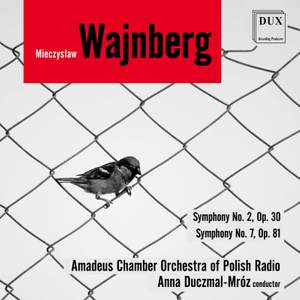
Dux DUX1631
Poland, 2020
Review: Weinberg's 7th symphony has received several excellent recordings, including a Soviet-era (1967) account by Rudolf Barshai, which is still definitive in many ways. Of the modern recorded versions, the one on Dux with Anna Duczmal-Mróz conducting the Amadeus Chamber Orchestra of Polish Radio is especially outstanding. Besides comparing very well with Barshai's rendition, the latter recording also includes Weinberg's 2nd symphony – also for strings – which is one of his best (early) symphonic works. Particularly notable is how Duczmal-Mróz manages to deftly draw colour from the sonic innovations which Weinberg introduces into the 7th symphony's final movement, though without over-emphasis. This alone makes the recording not just a good first choice, but an insightful alternative to its predecessors. In terms of alternatives, the recording on Chandos with Thord Svedlund conducting the Gothenburg Symphony Orchestra shares similar interpretative features, and occasionally makes a stronger case in terms of tempi – allowing, for example, the painful string writing in the symphony's 4th movement to be projected more accurately; however, the Chandos recording combines the 7th symphony with Weinberg's 1st, which, written very early in his career, is ultimately not one of his masterpieces in the genre and is mainly of historical interest. In terms of other alternatives, Mirga Gražinytė-Tyla's approach to the 7th symphony, which utilizes considerably slower tempi throughout, at first appears to emphasize the lyrical side of the work; however, this approach loses the rhythmic drive, energy and sharpness that characterizes much of the symphony (anyone wishing to “see” this can do so in the corresponding artwork of Annael at the bottom of the Music page). While Gražinytė-Tyla's leisurely tempi can, on occasion, have merit, they ultimately draw out and dilapidate the outlines of the individual movements, in opposition to the symphony's overall neo-classical aesthetic. Another downside of the DG recording is the seemingly distant placement of the harpsichord. In the Dux recording, the harpsichord is placed up-front and is clearly (perhaps even too clearly) audible; yet the use of a harpsichord is one of the distinct features of this symphony, hence its accentuation is more than justified.
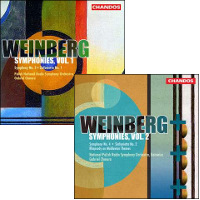
Chandos CHAN10237 (Vol. 2), CHAN10128 (Vol. 1)
UK, 2004, 2003
Review: The 4th and 5th symphonies, written only a few years apart, are both weighty, significant works from Weinberg's middle-period that share a similar atmosphere. Kirill Kondrashin conducts the Moscow Philharmonic Orchestra in the benchmark recordings of both symphonies, originally on Melodiya and licensed on Olympia and Russian Disc, respectively. While Gabriel Chmura's dynamic, hard-edged accounts with the National Polish Radio Symphony Orchestra on Chandos lack the finesse, warmth and humanness of Kondrashin, they nonetheless manage to capture the spirit of Weinberg's music very well, and are thus recommendable. The two sinfoniettas included on the respective Chandos releases, as well as the Moldovian Rhapsody on Vol 2, are colourful orchestral works that bring a lighter tone to the otherwise heavy listening programs.

Neos NEOS11126, Weinberg Series
Austria, 2011
Review:
The 17th symphony is the first of Weinberg's trilogy On the Threshold of War
. As Paul Rapoport notes in his Record Review article from 1997, in Russian the trilogy's title actually means “Having Crossed the Threshold of War”, which is more poetic than political and more suggestive than actual
. Given that Weinberg dedicated his 17th symphony to Vladimir Fedoseyev – one of Russia's great conductors – it would be paradoxical for Fedoseyev to not give an excellent account of the work. In his second live recording on the Neos label, Fedoseyev does just that. It is the preferable recording to an otherwise devoted version from Vladimir Lande on Naxos. To highlight just one distinction between the two, in the second movement Fedoseyev projects a reflective, dream-like atmosphere of past recollection, linking the themes with a subtle reference to Akhmatova's poetry, as per the symphony's epithet (“Memory”): "Upon the heart, the farewell kiss remains / Indelible [...] clocks tick on, and seasons come and go, / The names of cities change, events retain / No witnesses, and memories and tears / May not be shared" (transl. Irina Zheleznova). For Fedoseyev, the pressing third movement is insistent but measured, whereas under Lande's baton, the same movement sounds rushed. Overall, Lande's interpretation remains sympathetic to the music and its ideas, but does not match the insight of the symphony's dedicatee.
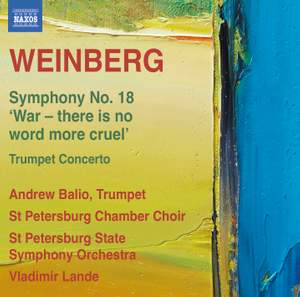
Naxos 8573190
Germany, 2014
Review:
What was said for Lande's interpretation of Symphony No. 17 cannot be said for his interpretation of Weinberg's Symphony No. 18, where a more temperate approach and the choir's somewhat more detached – yet more collected – sound suits the music more aptly than Fedoseyev's approach and overtly emotional, Soviet-era choir, in a 1985 live recording which in any case is long out-of-print. Indeed, Lande captures the symphony's poignancy and reserve in equal measure through both the instrumental first movement and remaining vocal movements. To quote Paul Rapoport again, the music's tendency to episodic structure [...] allows free association between the choral passages and the musical commentary that follows, often to striking effect. Particularly notable is [Weinberg's] treatment of the poems, which makes something of the words which is not sensed in their original form. For example, the description of war in Tvardovsky's poem [–] as cruel, sad and holy [–] is first presented that way, but at the end [is presented] in reverse order. Thus the imaginative a cappella music which ends the symphony leaves no doubt about the ultimate meaning of war.
At the same time, as with many other works on the theme, Weinberg uses war as a kind of symbol for the drama of life – replete with struggles, moments of darkness and despair, consolation, and finally, internal conciliation. In this sense, the 18th symphony (and this can be said of the 17th and 19th symphonies as well) is a work of reflection, not a Socialist-Realist monument of any kind.
Given the superior sound engineering from Naxos, one need not hesitate in acquiring Lande's rendition of this major work. The paired trumpet concerto (Weinberg's Op. 94, really a symphony-concerto) is likewise performed very well by Andrew Balio, capturing more of the music's lyricism than a reference recording by Timofei Dokshitser with the Moscow Philharmonic, though without employing drawn-out tempi. The militant elements in the concerto also connect well thematically with the 18th symphony, making for an auspicious pairing. No other Weinberg recording with Vladimir Lande on Naxos reaches the same level of inspiration and excellence as this one.
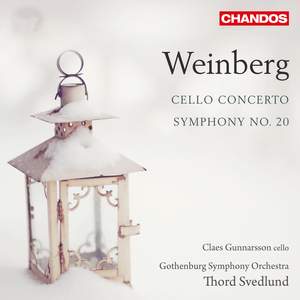
Chandos CHSA5107
UK, 2012
Review: Symphony No. 20 is an austere, serious work that showcases Weinberg's late, freely tonal (and sometimes polytonal) idiom in treating similar themes to its predecessors. It receives an excellent performance by the Gothenburg Symphony Orchestra, conducted by Thord Svedlund. The paired work, Weinberg's cello concerto, is perhaps one of the composer's most approachable pieces, superlatively performed by Claes Gunnarsson.
